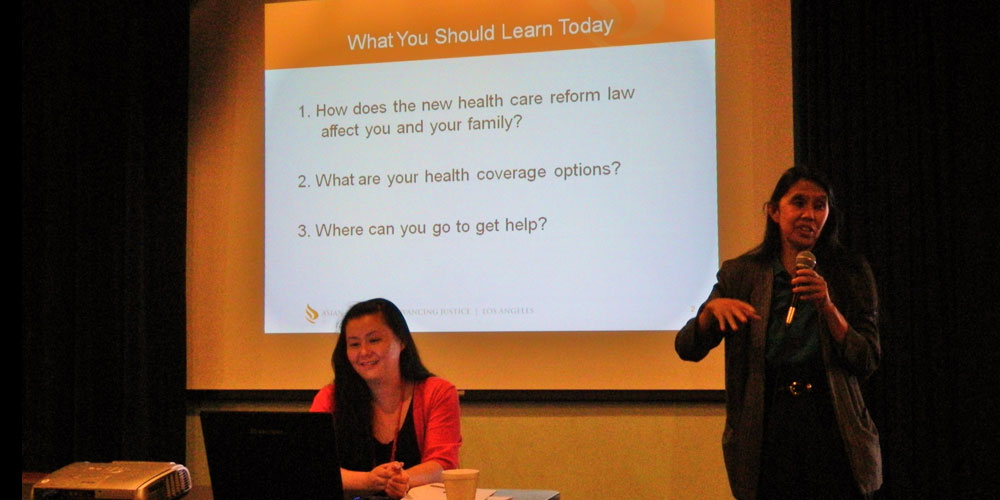LOS ANGELES—Community organizations are busy explaining to families and individuals how the new Affordable Care Act, more popularly known as Obamacare, provides the chance for the uninsured to get affordable health insurance.
One of them, the Search to Involve Pilipino American (SIPA), a non-profit organization, hosted an open forum for the community on September 14 at its headquarters in Historic Filipinotown.
Organizers from the Filipino American Service Group, Inc. (FASGI), Asian Americans Advancing Justice (AAJA-LA) and Organization of Chinese-Americans (OCA-Greater Los Angeles) explained how the recent healthcare reform will personally affect them and why getting the right insurance program will help them save in the long run.
Formally written as the Patient Protection and Affordable Care Act, this law allows people who are uninsured to get insurance from a public marketplace so they can receive health care coverage.
Currently, 14 percent of the six million uninsured Californians are Filipino-Americans who have high rates of heart disease, diabetes and cancer.
At present, there are three ways to get health coverage in Los Angeles: private health insurance through an employer or paid for personally; Healthy Way LA, which is a no-cost program through LA County Clinics, hospitals and partner clinics; and Medi-Cal, which is free health insurance for individuals with limited income.
Covered California
Starting Jan. 1, 2014, a new program under Obamacare will be launched called Covered California, the new marketplace to purchase affordable insurance for single households with an income of $15,860 and higher. Healthy Way LA will then merge with Medi-Cal to include individuals who earn $15,856 or lower annually.
Aside from size of household and income, what makes Covered California different from existing private health plans is it determines how much you pay based on age, zip code, health plan and benefit level selected–not on health status, gender, preexisting conditions and tobacco usage. It also offers tax credits for small business owners between 2010 and 2013 who will purchase insurance for their employees.
Doreena Wong, project director for AAJA-LA, said the biggest misconception in the Fil-Am community about the healthcare act is that the new insurance plans are going to be different and costlier.
“They are really private health plans, like what employers give to their employees, but you’ll be able to buy for the first time such quality health insurance—at affordable prices,” Wong explained. “You’ll be able to see exactly what services you have. This would make it a lot easier for people.”
Meanwhile, individuals paying for their private health insurance now will either pay the same amount or less, because the reform provides coverage for young adults 18-26 years old who can be on their parent’s insurance, children with preexisting conditions, free preventive services for seniors and children, and no lifetime limits for anyone who has maxed out their coverage.
Susan Espiritu Dilkes, executive director for FASGI, said that the reforms will be good for the people in the long run. “Parents can pay for their health insurance and it’s affordable,” Dilkes said. “The preventive care is a free service. It’s very, very attractive to us. Now you’ll want to be healthy. It’s less cost for the people, less cost for the government and less taxes for us if we think of being healthy.”
The more the merrier
However, because the law works on the premise that the greater number of insured people lowers overall cost and improves quality of service, it also states that everyone must sign up for some form of insurance or there will be penalties involved.
The Individual Responsibility Requirement mandates that most people must have health insurance or qualify for free or low-cost insurance. Otherwise, they will be penalized through the IRS 1 percent of their income starting Jan. 1, which gradually increases to 2.5 percent in 2016.
Jimmy Gomez, Assembly member for the 51st district, made an appearance at the event and emphasized the importance of signing up for the program as soon as possible. “In order for the cost to be spread out over a greater number of people, we need as many people signed up as possible,” Gomez explained. “The sooner we get more membership, the better off the Affordable Care Act is going to be, the more services people are going to have, the better it’s going to work.”
Gomez will be conducting more health fairs regarding the Affordable Care Act on Oct. 19 in Northeast LA.
Benedicta Velasco, a resident of LA, has been carefully taking in all the information. “I already have insurance,” she said. “I would like to share the information because there are so many Filipinos in my church that do not have health insurance. So, I would like to disseminate the information that I’m going to gather today for these people.”
Tan Wongprasert, also a local, said that she is satisfied with her Healthy Way program and does not mind the move to Medi-Cal. “I have access to the mobile health plan that will take you to the county hospital and I have lot of access to the local clinic,” Wongprasert said.
Sign-ups will start on Oct. 1, but people can start calculating their potential insurance cost on the Covered California website, CoveredCA.com.


